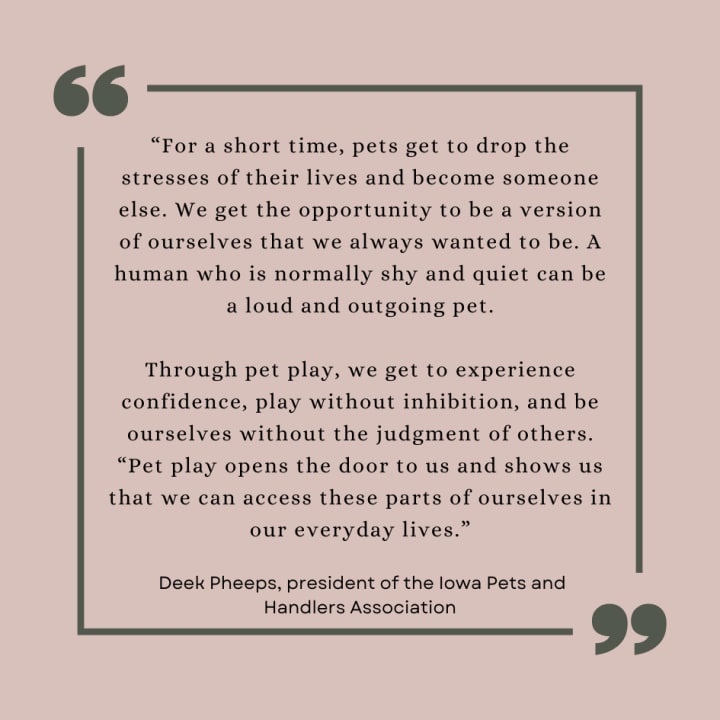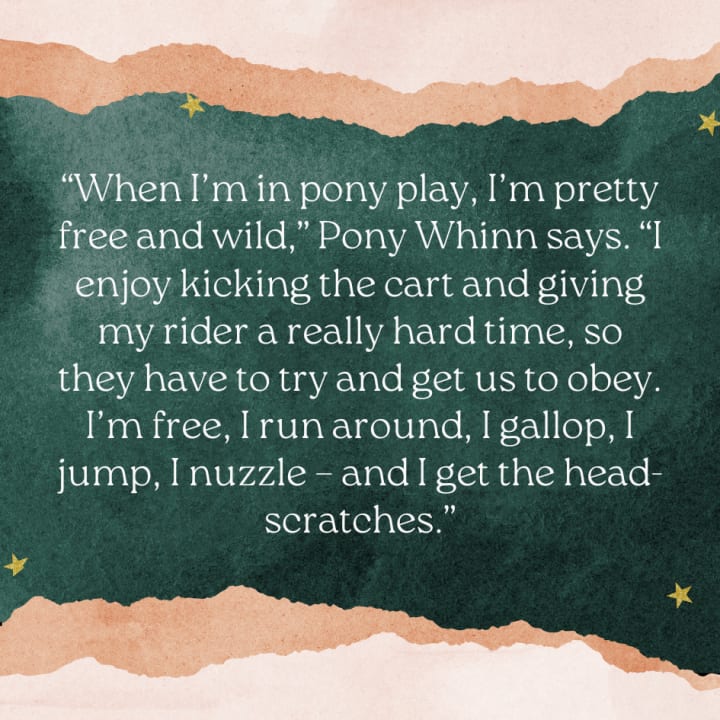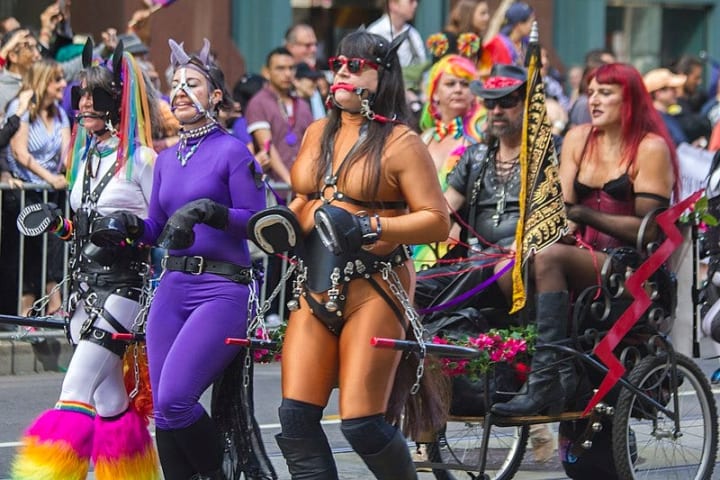Paws, Claws, and Curiosity: A First-Timer's Guide to Pet-Play
Understanding the appeal, the roles, and the community.

What Is Pet Play?
Ever felt the urge to ditch your human worries and leap into the carefree life of your furry friends? Welcome to the whimsical realm of pet play, where your inner animal gets to romp and roar free!
This surprisingly prevalent kink invites participants to embody their chosen animal personas through a playful blend of behaviours, mannerisms, accessories, and a dash of imagination.
Imagine barking at the moon, purring with contentment, or hopping around without a single care in the world. Pet play enthusiasts do all that and more, adopting the mannerisms and even the adorable physical traits of their animal alter-egos. From fluffy tails to perky ears, the right gear can transform an ordinary day into an extraordinary exploration of your primal side.
But here's the best part, it's not all about the wild romps in the bedroom. Many are drawn to pet play for the freedom it offers from the complex web of human existence. It's a chance to shed the burdens of your adult life and revel in the simplicity and innocence of being a creature of pure instinct. This unique form of roleplay is an oasis of stress relief, a playground where power dynamics, trust, and care weave a tapestry of deep connection between participants.
For those ready to take a walk on the wild side, pet play offers a buffet of activities to engage in. Whether you're keen on mastering the perfect meow or finding joy in the simplicity of being led on a leash, the experience is as rich and varied as the animal kingdom itself. And in the sanctuary of pet play, every growl, purr, chirp, and wag is a step closer to discovering the untamed parts of your soul.
What It Isn't
First things first, let's tackle the elephant in the room. Pet play is not bestiality!
I really can't express this enough: pet play is not bestiality! Understandably, for individuals who are not familiar with it, the pet play community may appear unusual or unconventional. Unfortunately, that non-familiarity and lack of knowledge about this fetish lead to a negative perception by outsiders, who tend to unfairly judge and marginalise those participating in it.
Indeed, pet play is a form of role-play between consenting adults who adopt animal personas or pets and their caretakers, usually within the context of a BDSM dynamic. This role-play is consensual, imaginative, and part of a human-to-human interaction. Real-life animals are never involved in pet play.

Furthermore, it's worth mentioning that individuals who participate in pet play do not have a genuine desire to become real animals, even though they may adopt animal personas. They're not looking to quit their day jobs to start life anew as Fluffy or Fido and start chasing the mailman. Participants comprehensively grasp their own humanity and acknowledge that their roles are entirely fictional.
Instead, they're tapping into a deep well of imagination, exploring the psychological allure of embodying traits they admire in their favourite animals.
What's The Appeal?
So what's the draw? Well, at its heart, pet play is about liberation. Imagine being able to press pause on the ceaseless demands of adulting and instead, for a brief spell, prance around with the carefree spirit of a puppy, the aloof grace of a cat, or the noble stature of a horse. Pet play offers a unique escape hatch from reality, a safe space where participants can explore different facets of themselves and their relationships without the constraints of human societal roles.

Furthermore, although pet play can certainly involve sexual aspects, it's far from its sole purpose. Many are drawn to the non-sexual elements - the emotional bond, the structure and dynamics of the pet and owner relationship, and the sheer joy of unconditional companionship. The pet play dynamic fulfils emotional and psychological needs by providing a sense of security, care, and affection through various roles and interactions.
Pet-Play Glossary
In the diverse world of pet play, a wide range of terms and roles define the unique dynamics and relationships formed between participants, including:
Human Pet
A human pet is someone who willingly assumes the role, behaviour, and sometimes even the appearance of an animal during pet play. The specific animal role can vary widely, and there is certainly no shortage of animals to choose from. Although kittens, ponies, pigs, and puppies are the most popular, there are many others, such as foxes, cows, wolves, bunnies, and even fantastical creatures like dragons.
Owner
In pet play, an Owner is a permanent, nurturing figure who cares for the pet, provides affection, and assumes overall ownership. This role goes beyond just playing and often becomes intertwined with the pet's daily life, fostering a solid emotional connection.
Understandably, the relationship between the Owner and their pet is profoundly personal and intimate. The Owner dedicates their time, emotions, and sometimes even financial resources to ensure the well-being and satisfaction of their pet.
Handler
In contrast, a Handler's role is typically more short-term, focusing on the training, discipline, and obedience of the pet. Handlers shine in scenarios that require a firm yet guiding hand, such as public play sessions or training routines. Their focus is on tasks and ensuring everything runs smoothly. Typically, Handlers use commands, tasks, and occasionally corrective measures to ensure obedience and improve the pet's overall skills and demeanour.
While the bond between a Handler and a pet may not possess the same level of long-term commitment and emotional intensity as that between an Owner, it is still built on respect, structure, and mutual understanding.
Puppy Play
As the name suggests, puppy play is a form of role-playing in which individuals adopt the characteristics and behaviours of puppies.

This can include barking, fetching, and showing loyalty to their Owner or handlers. Participants enjoy the freedom to express playfulness, obedience, and the simplicity of a pup's life.
Pup Space
Pup space is a state of mind where someone fully embraces the role of a puppy, embracing its playful, carefree nature and instinctual behaviours. This role-play extends beyond mere imitation, touching on deep-seated desires for affection, exploration, and, sometimes, a break from the complexities of human social existence.
"Most people live stressful lives. I balance a schedule, navigate traffic, try to save money, and go to the gym five or six times a week. My pup headspace is a chance to break from all that." - Alexander Cheves, a sex-positive writer and blogger.
The allure of pup space can be multi-dimensional. It allows individuals to freely express aspects of their identity or inner self that feel most authentic and vulnerable. It also provides a way to escape from the pressures and responsibilities of adult life and seek solace in a world of simplicity, guided by actions and emotions rather than words.
Kitten Play
Like puppy play, kitten play lets participants channel their inner feline, complete with all the curiosity, affection, and playful independence that kittens are known for. It's not all purrs and cuddles, though - expect a dash of mischievous independence, too. Whether it's chasing laser pointers or curling up for a nap, kitten play is perfect for those looking to express their softer, more playful side.
Pony Play
For those who prefer the gait of a gallop, pony play offers a chance to embody the grace and strength of a horse or pony. This niche within pet play involves everything from trotting and carrying to pulling carts, often enhanced with equestrian gear like bridles and bits.

Safety Measures
A crucial aspect of engaging in pet play, like any other activity within BDSM, is the fundamental importance of obtaining and retaining consent. Engaging in pet play requires participants to establish mutual agreement, set clear boundaries, and maintain thorough communication. This foundation guarantees the experience stays positive, respectful, and enjoyable for all participants.
Building upon the previous point, it is essential to establish a safe word to create a consensual and secure environment for everyone participating in pet play and other BDSM activities. A safe word provides a reliable way to communicate their need to pause, slow down, or stop an activity if they feel uncomfortable, distressed, or need immediate help.
Of course, by the very nature of pet play, there may be times when verbal communication of a safe word is impractical because you are gagged, muzzled, or your handler demands silence. In such times, it can be beneficial to have a non-verbal signal to indicate a desire to pause or stop the activity.
Similar to its spoken equivalent, a nonverbal safe signal indicates to your partner that changes or ending the scenario might be required.
Pinching, tapping, snapping fingers, and hand squeezing are examples of non-verbal safe signals. A bell, squeaky toy, or other nearby noisy object can also effectively stop play when it gets too intense.
Check-ins at regular intervals are another safety measure to consider during play. Whether it's a gentle "Are you okay?" from the dominant (your beloved Owner or Handler) or a mutual check-in, these moments are crucial. They ensure everyone is still having a blast and feeling good about the experience. Plus, they offer an opportunity to adjust the play as needed, making sure it stays fun and safe for all.

When using restraints, collars, masks, or any other equipment, you must know how to use and care for them properly to minimise any harm they may pose. Get acquainted with the proper usage and make sure they can be easily removed if needed.
Lastly, after the session ends, it is generally advised to have an open and honest conversation about your individual experiences, what aspects you found pleasurable, and any adjustments necessary for future play. Open and honest communication is essential for personal growth and ensuring a fulfilling experience in pet-play dynamics.
Want To Give It A Go?
Beginning pet play can be as simple or complex as you and your partner prefer. Some couples may choose to explore alternative dynamics within their relationship, incorporating unique gestures and commands that add a new level of intimacy and connection. Some individuals may choose to designate certain periods and locations for engaging in pet play.
Choosing the right pet persona involves self-reflection and open communication. Choosing something that aligns with who you are, what you want, and the kind of experience you're looking for is important. Is a noble and graceful pony more your speed and style, or perhaps a playful and inquisitive kitten? Take into account your physical capabilities and comfort levels as well.
Kindly note that your persona is not set in stone. Try new things and make changes as you go along; that's how you learn and develop.
Accessories and outfits can significantly enhance the pet play experience, creating a more authentic and immersive atmosphere for the roles involved. Begin by selecting essential items like collars, leashes, tails, and plugs, prioritising comfort and safety. It's crucial to consider and respect each other's boundaries regarding what accessories are enjoyable or unacceptable. It's important to keep in mind that these elements are meant to improve the experience, not create unnecessary stress.

Engaging with the broader pet-play community can provide helpful support, encouragement, and camaraderie. You can establish meaningful connections with individuals who share your interests by delving into online forums and social media groups or participating in events and workshops centred around pet play.
Exploring various animal roles can be valuable for uncovering what truly resonates with you and your partner. It's important to note that there are multiple ways to engage in pet play, and no one approach is considered the absolute "right" way. It is crucial to prioritise mutual enjoyment, respect, and ongoing consent from all parties involved.
About the Creator
Chelsea Rose
I never met a problem I couldn't make worst.






Comments
There are no comments for this story
Be the first to respond and start the conversation.